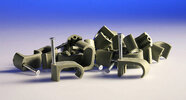So as some of you guys may know I'm about to fit a socket behind the TV on the chimney breast.
I will be using
2.5mm twin and E cable.
13A double socket ..( shall this be single or double pole ??)
25mm metal back box ( is this right size ?)
Grommet
PVC conduit
In terms of filling
PVA glue
Bonding powder
Easifil powder.
Does this all sound right?
I will be using
2.5mm twin and E cable.
13A double socket ..( shall this be single or double pole ??)
25mm metal back box ( is this right size ?)
Grommet
PVC conduit
In terms of filling
PVA glue
Bonding powder
Easifil powder.
Does this all sound right?



